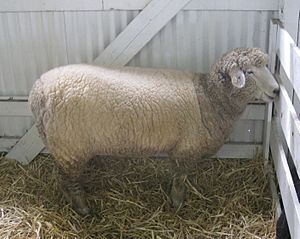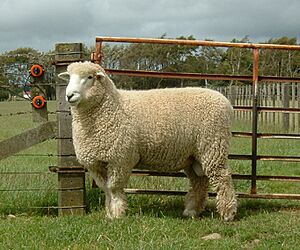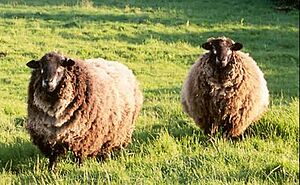Romney sheep facts for kids
The Romney sheep, also known as the Romney Marsh sheep or simply the Kent by local farmers, is a type of sheep that first came from England. This breed is known for its "long wool" and was officially recognized in England by the year 1800. Romney sheep have been sent to many other parts of the world and are very important for the economy, especially for countries like New Zealand that export sheep meat and wool.
Contents
History of Romney Sheep
Where Did Romney Sheep Come From?
The Romney breed developed from older types of long-wooled sheep that lived during the Middle Ages. The Romney and Leicester breeds are early examples of these. By 1800, the sheep known as "Romney Marsh" or "Kent" had been improved. This was done by breeding them with English Leicester sheep, which made their bodies stronger and their wool better quality.
How Romney Sheep Spread Around the World
The first time Romney sheep were definitely sent out of England was in 1853. Twenty sheep from Stone, Kent, traveled on a ship called the Cornwall to New Zealand. Later, in 1856, 30 more ewes (female sheep) were sent. With these sheep, Alfred Ludlum started New Zealand's first Romney Marsh farm in 1860 in the Hutt Valley. Ludlam's brother-in-law, Augustus Onslow Manby Gibbes, also raised them in Australia at his famous farm, Yarralumla.
In 1855, New Zealand had about 60,000 Merino sheep. However, the Romney Marsh sheep grew faster and became more common than the Merino sheep in most parts of the country. The New Zealand Romney Marsh Association was created in 1904. Alfred Matthews was its first president, and the farm he started, Waiorongamai, is still raising Romneys today.
By 1965, three-quarters (75%) of all the sheep in New Zealand were Romneys. By the mid-1990s, Romneys made up 58% of New Zealand's sheep flock. Other breeds like Coopworths (which are a mix of Border Leicester and Romney) and Perendales (a mix of Cheviot and Romney) made up another 16.6%.
New Zealand started exporting lamb meat in 1882. A ship called the Dunedin carried 4,900 frozen lamb bodies to London's Smithfield Market. This was the largest amount of meat ever shipped such a long distance at that time. February 15, the day the ship left, is still celebrated as New Zealand Lamb Day. After 1932, new ways of shipping chilled fresh meat by sea and later by air helped the export business grow even more.
Romney sheep are not just raised in England and New Zealand. They are also found in places like Patagonia, Australia, Portugal, Brazil, Canada, and Southern California. For many years, England was the main place that exported Romney sheep. Between 1900 and 1955, 18,000 rams (male sheep) and 9,000 ewes were sent from England to 43 different countries. New Zealand also started exporting Romneys after one of their rams won a big award in Argentina in 1906. In recent years, rules about animal health have made New Zealand and Australia almost the only places that export Romney breeding sheep. Countries like Brazil, Uruguay, the Falkland Islands, the U.S., and even England itself now get their Romney sheep from these places.
What Romney Sheep Look Like
Special Qualities of Romney Sheep
Romney sheep are known for being quite strong. They can live happily even when many sheep are kept together. Some large Romney flocks in New Zealand have shown that ewes can have more than 1.7 lambs for every ram they are bred with, which is a good number, and the lambs usually survive well.
Many descriptions of Romney sheep mention that they are quite resistant to foot rot, a common problem for sheep. An old American text from 1918 said, "It is said that foot rot and liver fluke seldom affect Romney Marsh sheep." A more recent book says, "Romneys are said to be somewhat resistant to foot rot, liver flukes and other problems that often plague sheep in damp pastures." This means they are good for places with wet fields.
How to Identify a Romney Sheep
Romney sheep generally have an open face, meaning their face is not covered by wool. They have long wool that grows fully over their legs. The rules for what makes a "perfect" Romney sheep are a bit different in various countries, but they share many common points. The oldest Romney sheep club in England (started in 1895) set these standards in 1991:
- The head should be wide and flat between the ears.
- They should not have horns or dark hair on the top of their head (the poll).
- Their eyes should be large, bright, and easy to see.
- Their mouth should be healthy.
- Ewes (females) should have a full face, and rams (males) should have a broad, strong-looking face.
- Their nose and hooves should be black.
- The neck should be strong and not too long, joining well at the shoulders.
- Shoulders should be well-placed and level with the back.
- The chest should be wide and deep.
- The back should be straight and long, with a wide and deep loin (lower back).
- The rump (rear) should be wide, long, and well-shaped.
- The tail should be almost even with the chine (backbone).
- The thighs should be well-developed.
- The face should be white, and the skin should be a clean pink color.
- The ribs should be well-rounded.
- Legs should be well-placed, with strong bones and healthy feet.
- Sheep should stand well on their pasterns (part of the leg above the hoof).
- The wool (fleece) should be white, have an even feel, and a good, clear staple (length and quality of wool fibers) from head to tail. It should also be free from kemp (coarse, brittle fibers).
Romney sheep can have either white or colored wool. Today, Romney sheep can vary in size, even within the same country. They are generally considered a larger sheep breed. For example, an English description says ewes can weigh up to 85 kg (about 187 pounds) and rams up to 110 kg (about 242 pounds). The American standard says ewes should be 140 pounds or more, and rams 200 pounds or more.
Romney Wool Qualities
Romney sheep produce a lot of wool. A healthy adult ram can give more than 10 kg (about 22 pounds) of wool each year when it's shorn. For ewes in New Zealand, the average is usually more than 5 kg (about 11 pounds). The wool from long-wooled sheep like Romneys is heavier because the fibers are longer. Sheep with finer wool, like Merinos, have more wool follicles (where the wool grows from), but each fiber grows slower and is shorter when shorn. Romney wool also has a high "clean yield," meaning that after it's washed thoroughly, 75-80% of its original weight remains. This is higher than most fine-wooled sheep.
The most important feature of wool, which helps decide what it's best used for, is its average fiber diameter (AFD). This measures how thick each wool fiber is. Romneys have strong wool, meaning their AFD is higher than many other sheep breeds. Wool with a high AFD is best for things like carpets and other tough uses. Wool with a very low AFD (like from Merinos) is perfect for fine suits and fancy clothes. AFD is measured with special tools. The traditional "Bradford system" uses experienced people to feel and look at the wool, but it can sometimes be inaccurate. The American Romney Breeders Association says Romney wool should be "44s to 50s" by the Bradford system. In New Zealand, the standard is "44s to 52s."
Romney wool is great for hand-spinning and is often suggested for beginners. In the United States, where there isn't much commercial use for strong wool grown there, hand-spinners are the main buyers of Romney wool. However, only a small part of the thousands of Romney fleeces shorn in the U.S. each year are sold for this special use.
In New Zealand, most Romney wool is sent to factories in Europe, Asia, the U.S., Australia, and New Zealand itself to make rugs and carpets. More and more of it is now going to China. New Zealand is the world's biggest producer and exporter of "strong crossbred" wool (wool with an average fiber diameter of more than 35.4 microns). In 2002–2003, New Zealand exported about 138,000 tonnes of wool (after washing). About half of this was Romney-type wool. In the same year, wool exports brought in almost NZ$1 billion, which was about 3% of the country's total money from goods exported.
In North America and England, Romney sheep with natural colors (not white, but black, gray, silver, or mixed colors) are valued. Hand-spinners and weavers like these natural colors. In the past, naturally colored (or "black") sheep were not liked because even a small amount of black fiber on a white sheep could ruin a lot of white fabric.
Since 1972, naturally colored Romneys have been registered with the American Romney Breeders’ Association (started in 1911), which has a special standard for them. In New Zealand, naturally colored Romneys can be registered with the Black and Natural-colored Sheep Breeders Association. However, many breeders of white Romneys still view them with some caution.
Why Romney Sheep Are Important to the Economy
Because there are so many Romney ewes and lambs in New Zealand, this breed is the biggest source of wool for both international and local trade. It is also a major part of New Zealand's frozen lamb export business, both as purebreds and as first-generation crosses (when Romneys are bred with other sheep). New Zealand is the world's largest exporter of frozen and chilled lamb meat. In 2008, New Zealand's sheep-meat exports (mostly lamb) brought in more than half of the country's NZ$4.5 billion in meat export money.
See also
 In Spanish: Romney (oveja) para niños
In Spanish: Romney (oveja) para niños




